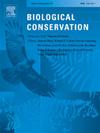Declining trajectories characterise arboreal marsupial assemblages in eastern Australia
IF 4.9
1区 环境科学与生态学
Q1 BIODIVERSITY CONSERVATION
引用次数: 0
Abstract
Understanding species responses to global change requires robust information on species trajectories across their distributions. However, few studies have documented long-term trajectories in different populations of the same taxon in multiple parts of its distribution. We quantified temporal trajectories in arboreal marsupial detection across 671 field sites within four independent large-scale, long-term studies, located in three major bioregions spanning ∼ 1000 km of latitude in eastern Australia. Using Bayesian generalized linear mixed models, we analysed the trajectories of nine arboreal marsupial species across our four studies, yielding 11 response curves overall for temporal change in the probability of detection. There was evidence of declines in detection probability in seven cases. We identified several places where most species were declining, indicating the potential for homogenisation in arboreal marsupial assemblages. There were increases in detections in four cases across our four studies; two of these were for the Common Brushtail Possum (Trichosurus vulpecula). We found between-study differences in temporal trajectories of the Common Ringtail Possum (Pseudocheirus peregrinus) and Krefft's Glider (Petaurus notatus) (also known as the Inland Sugar Glider), highlighting the existence of non-stationarity (i.e. spatial variation in temporal trajectories) in those taxa. The declines we documented encompassed taxa with a range of life history attributes and included rare species (e.g. the Southern Greater Glider (Petauroides volans)) as well as some previously relatively common species in particular areas (e.g. the Common Ringtail Possum). This underscores the importance of avoiding complacency in conservation and cautions against assuming security of currently common species.
澳大利亚东部树栖有袋类动物群落的下降轨迹
了解物种对全球变化的反应需要关于物种分布轨迹的可靠信息。然而,很少有研究记录了同一分类单元的不同种群在其分布的多个部分的长期轨迹。在四个独立的大规模长期研究中,我们量化了671个野外地点的树栖有袋动物检测的时间轨迹,这些地点位于澳大利亚东部跨越1000公里纬度的三个主要生物区。利用贝叶斯广义线性混合模型,我们分析了四项研究中九种树栖有袋动物的轨迹,得到了11条总体响应曲线,反映了检测概率的时间变化。有证据表明,有7个病例的检测概率下降。我们发现了几个物种数量下降的地方,这表明在树栖有袋动物群落中存在同质化的可能性。在我们的四项研究中,有四例病例的检出率增加;其中两个是普通刷尾负鼠(Trichosurus vulpecula)。我们发现了环尾负鼠(Pseudocheirus peregrinus)和克雷夫特滑翔机(Petaurus notatus)(也被称为内陆糖滑翔机)的时间轨迹在研究间的差异,突出了这些分类群的非平稳性(即时间轨迹的空间变化)的存在。我们记录的物种数量下降包括具有一系列生活史属性的分类群,包括稀有物种(如南方大滑翔机(Petauroides volans))以及一些以前在特定地区相对常见的物种(如普通环尾负鼠)。这强调了在保护中避免自满的重要性,并警告不要假设目前常见物种的安全。
本文章由计算机程序翻译,如有差异,请以英文原文为准。
求助全文
约1分钟内获得全文
求助全文
来源期刊

Biological Conservation
环境科学-环境科学
CiteScore
10.20
自引率
3.40%
发文量
295
审稿时长
61 days
期刊介绍:
Biological Conservation is an international leading journal in the discipline of conservation biology. The journal publishes articles spanning a diverse range of fields that contribute to the biological, sociological, and economic dimensions of conservation and natural resource management. The primary aim of Biological Conservation is the publication of high-quality papers that advance the science and practice of conservation, or which demonstrate the application of conservation principles for natural resource management and policy. Therefore it will be of interest to a broad international readership.
 求助内容:
求助内容: 应助结果提醒方式:
应助结果提醒方式:


